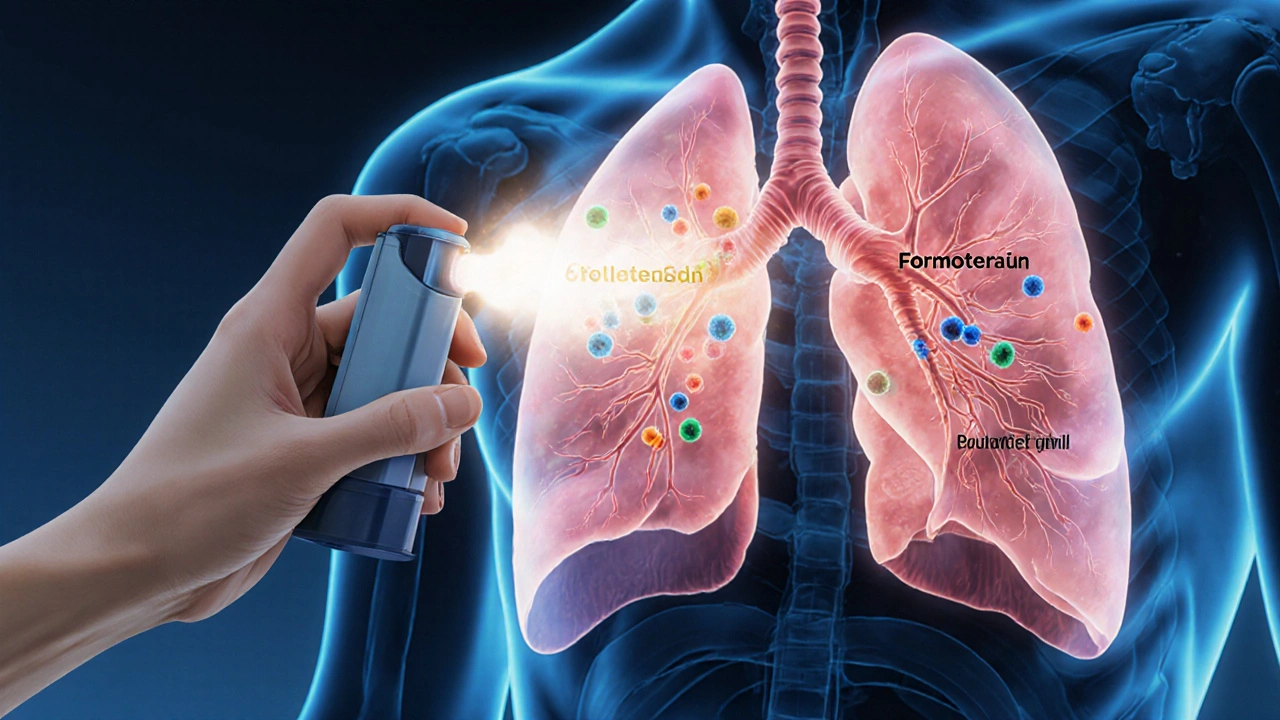Asthma Inhaler Comparison Tool
Select Your Priority Factors
Answer these questions to find inhalers that best match your needs
Recommended Options
Key Considerations
Remember: This tool helps you narrow down options, but always discuss your choice with your healthcare provider. Different inhalers have different mechanisms of action, side effect profiles, and coverage options.
Ever wonder whether Symbicort is really the right inhaler for your asthma or COPD, or if another option might fit you better? You’re not alone. Millions of patients face the same question, and the answer depends on a mix of drug ingredients, dosing convenience, side‑effects, and insurance coverage. This guide breaks down Symbicort and its main rivals, so you can see the differences side by side and decide which inhaler aligns with your health goals.
What Is Symbicort?
Symbicort is a combination inhaler that delivers budesonide, an inhaled corticosteroid, and formoterol, a long‑acting beta‑agonist (LABA). First approved in 2006, the device is used for both asthma maintenance and chronic obstructive pulmonary disease (COPD). Budesonide reduces airway inflammation, while formoterol relaxes the muscles around the airways, keeping them open for up to 12 hours. The twin‑action formula means you get anti‑inflammatory control plus bronchodilation in a single puff, which many patients find convenient compared with taking separate pills or inhalers.
How Symbicort Works: The Science in Simple Terms
- Budesonide - a corticosteroid that dampens the immune response in the lungs, lowering swelling and mucus production.
- Formoterol - a LABA that activates beta‑2 receptors, relaxing smooth muscle and widening the airway passage.
- Both drugs are delivered as a fine mist directly to the lungs, reducing systemic exposure and side‑effects compared with oral steroids.
Because the two ingredients act on different pathways, the combination can control symptoms better than either component alone. Clinical trials show a 30‑40% reduction in asthma exacerbations when patients stick to the prescribed twice‑daily schedule.
Key Criteria When Comparing Inhalers
Before we jump into the side‑by‑side table, think about what matters most to you. Answering these questions will help you weigh the numbers later:
- Do you need a maintenance inhaler only, or a dual device that also offers quick relief?
- How important is once‑daily dosing versus twice‑daily?
- Are you sensitive to steroids and worried about oral thrush?
- What does your insurance cover? Some plans favor certain brands.
- Do you prefer a metered‑dose inhaler (MDI) or a dry‑powder inhaler (DPI)?
With those points in mind, let’s see how Symbicort stacks up against the most common alternatives.

Comparison Table: Symbicort and Its Main Rivals
| Inhaler (Brand) | Active Ingredients | Device Type | Typical Dosing Frequency | Approved Use | Common Side‑effects |
|---|---|---|---|---|---|
| Symbicort | Budesonide+Formoterol | Metered‑dose inhaler (MDI) | Twice daily | Asthma maintenance, COPD | Oral thrush, hoarseness, tremor |
| Advair | Fluticasone+Salmeterol | Dry‑powder inhaler (DPI) | Twice daily | Asthma, COPD | Cough, headache, throat irritation |
| Dulera | Mometasone+Formoterol | MDI | Twice daily | Asthma (children≥4y) | Oral thrush, hoarseness |
| BreoEllipta | Fluticasone+Vilanterol | DPI | Once daily | Asthma, COPD | Upper‑respiratory infection, oral thrush |
| Pulmicort | Budesonide (mono‑therapy) | MDI | Twice daily | Asthma maintenance | Oral thrush, cough |
| Albuterol | Albuterol (short‑acting beta‑agonist) | MDI or DPI | As needed | Quick‑relief rescue | Tremor, palpitations, nervousness |
Pros and Cons: Quick‑Read Summary
- Symbicort - Good balance of anti‑inflammation and bronchodilation; twice‑daily regimen good for steady control; may cause oral thrush if not rinsed.
- Advair - Similar efficacy, but the DPI requires a strong inhalation flow, which can be tricky for some COPD patients.
- Dulera - Offers the same formoterol component as Symbicort, but uses mometasone, a slightly more potent steroid; pediatric label is a plus.
- BreoEllipta - Once‑daily dosing is a convenience winner; however, the higher dose of vilanterol may increase heart‑rate side‑effects.
- Pulmicort - Steroid‑only, ideal if you don’t need a LABA; but you’ll need a separate rescue inhaler.
- Albuterol - Fast‑acting rescue only; not meant for daily control, so it can’t replace a maintenance combo.

How to Choose the Best Inhaler for Your Situation
Imagine you’re sitting with your doctor, the prescription pad open. Here’s a quick decision tree you can run through:
- Do you need a rescue inhaler? If yes, keep a short‑acting bronchodilator like albuterol on hand - it’s not a substitute for maintenance therapy.
- Do you prefer once‑daily dosing? If convenience is your top priority, BreoEllipta’s 24‑hour coverage might win.
- Are you sensitive to inhaled steroids? Consider a lower‑dose steroid such as budesonide (Symbicort) or mometasone (Dulera) and always rinse after use.
- Do you have trouble generating enough inspiratory flow? An MDI (Symbicort, Dulera, Pulmicort) may work better than a DPI.
- Insurance coverage? Some formularies favor Advair or generic budesonide inhalers, which can lower out‑of‑pocket costs.
Cross‑checking these answers against the table above will narrow the field to one or two candidates you can discuss with your clinician.
Practical Tips for Getting the Most Out of Your Inhaler
- Always shake an MDI (like Symbicort) before each use.
- Prime a new inhaler with a few test sprays into the air.
- Rinse your mouth with water (no swallowing) after each dose to prevent thrush.
- Set a reminder on your phone for the twice‑daily schedule - missed doses reduce effectiveness.
- Keep a spare inhaler in your bag, car, or at work in case of emergencies.
Frequently Asked Questions
Can I use Symbicort as a rescue inhaler?
No. Symbicort’s formoterol component works quickly (within minutes) but is designed for regular use, not for sudden attacks. Keep a short‑acting bronchodilator like albuterol for immediate relief.
Is the steroid dose in Symbicort higher than in Pulmicort?
Both contain budesonide, but Symbicort combines it with formoterol, so the overall steroid exposure is similar per puff. However, because you’re using a LABA as well, the clinical effect feels stronger.
What’s the main advantage of a once‑daily inhaler like BreoEllipta?
Convenience. One dose a day reduces the chance of missed doses and fits better into busy lifestyles. The trade‑off can be a slightly higher steroid dose and a newer LABA with a longer half‑life.
Do I need a spacer for Symbicort?
A spacer isn’t required for most adults, but it can help children or anyone who struggles with coordination. It reduces oropharyngeal deposition and may lower the risk of thrush.
Which inhaler is safest for pregnancy?
Inhaled steroids like budesonide (Symbicort, Pulmicort) are generally considered low‑risk in pregnancy, but you should discuss any LABA use with your OB‑GYN. Some clinicians prefer a steroid‑only inhaler during the first trimester.
Bottom line: there’s no one‑size‑fits‑all answer. The right inhaler balances efficacy, convenience, side‑effect profile, and what your insurance will cover. Use the table, weigh your personal priorities, and have an open conversation with your healthcare provider. With the right choice, you can keep breathing easy and focus on living your life.





Rohit Sridhar
October 17, 2025 AT 21:37Finding the right inhaler can feel overwhelming, but you’ve already taken the biggest step by researching your options. Think of Symbicort as a two‑in‑one tool that tackles inflammation and bronchodilation together, which many people find convenient for a twice‑daily routine. If you struggle with the coordination of a DPI, the MDI format of Symbicort might actually be a smoother fit for you. Remember to rinse your mouth after each use – it’s a simple habit that cuts down on thrush and keeps you comfortable. Keep an open dialogue with your doctor, and you’ll land on the device that matches your lifestyle and breathing goals.
Bethany Torkelson
October 29, 2025 AT 20:37That “convenient two‑in‑one” line is just marketing fluff; you’re still exposing yourself to steroids twice a day. If you can tolerate a once‑daily regimen, why settle for the extra pill burden? The data shows comparable outcomes with BreoEllipta and fewer side‑effects.
Grace Hada
November 10, 2025 AT 20:37Your choice of inhaler reflects the same existential trade‑off between control and freedom that defines human agency.
alex montana
November 22, 2025 AT 20:37Honestly??!! You think a “quick read” summary actually replaces a doctor’s advice...?? No, it doesn’t-just a smidge of hype; read it, smile, move on…
Wyatt Schwindt
December 4, 2025 AT 20:37I hear you, and I respect that each device has its own learning curve.
Lyle Mills
December 16, 2025 AT 20:37When evaluating inhaler options, consider pharmacokinetic parameters such as the onset of action of the LABA and the particle size distribution of the aerosol, which influences deposition in the peripheral airways. An MDI like Symbicort delivers a metered dose of budesonide (ICS) and formoterol (LABA) with a fine particle mass (FPM) suitable for both central and distal lung regions. DPI devices rely on inspiratory flow rates exceeding 60 L/min to achieve optimal dispersion, which can be a limiting factor in severe COPD where airflow is compromised. Moreover, bioequivalence data suggest that budesonide’s glucocorticoid receptor affinity remains consistent across delivery platforms, but the systemic exposure profile may vary due to oropharyngeal deposition. Finally, adherence metrics improve when patients select a device that aligns with their dexterity and lifestyle, reinforcing the importance of shared decision‑making.